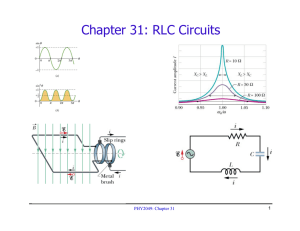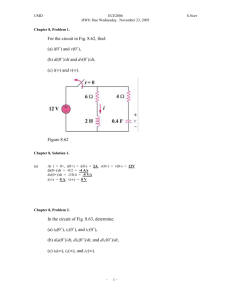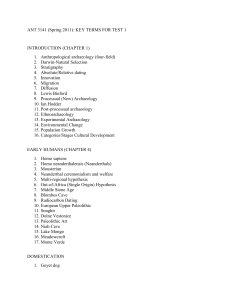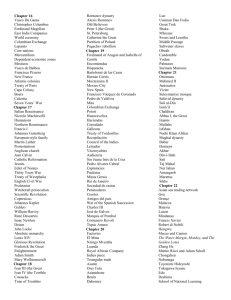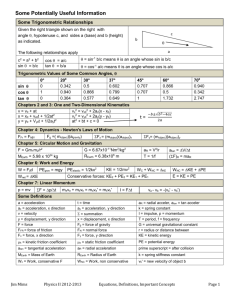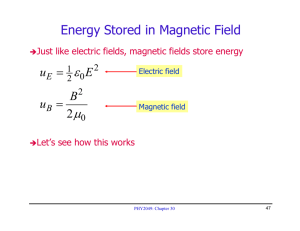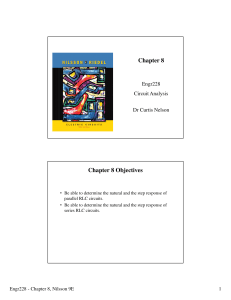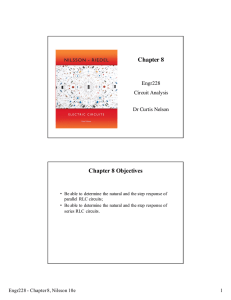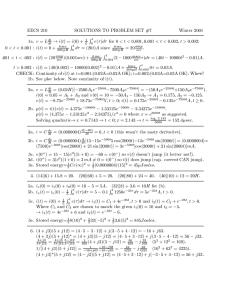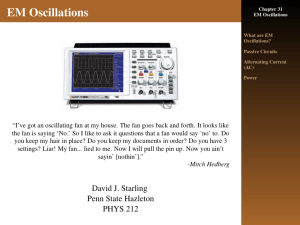Chapter 31: RLC Circuits PHY2049: Chapter 31 1
advertisement
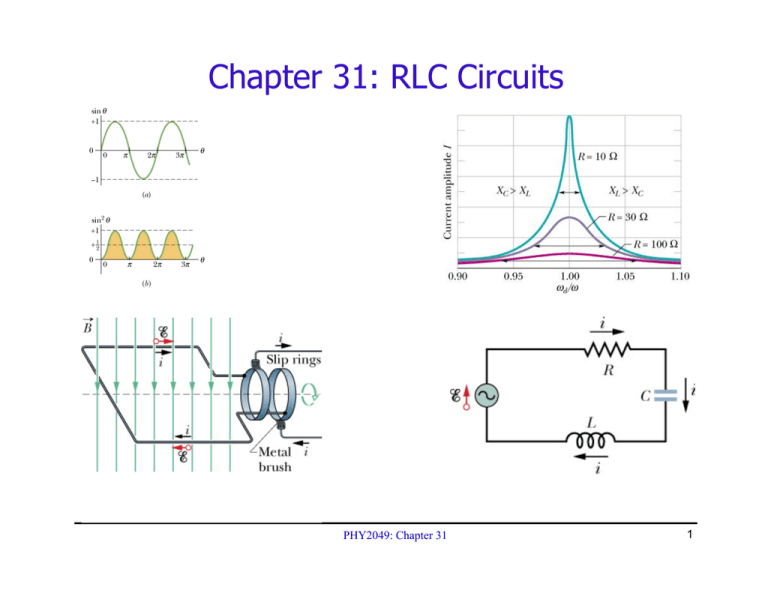
Chapter 31: RLC Circuits PHY2049: Chapter 31 1 Topics ÎLC Oscillations Conservation ÎDamped Energy ÎAC of energy oscillations in RLC circuits loss current RMS ÎForced quantities oscillations Resistance, reactance, impedance Phase shift Resonant frequency Power ÎTransformers Impedance matching PHY2049: Chapter 31 2 LC Oscillations ÎWork out equation for LC circuit (loop rule) q di − −L =0 C dt ÎRewrite C using i = dq/dt d 2q q d 2q 2 + ω L 2 + =0 ⇒ q=0 2 C dt dt ω L ω= 1 LC (angular frequency) has dimensions of 1/t ÎIdentical m d 2x dt 2 to equation of mass on spring + kx = 0 ⇒ d 2x dt 2 +ω x = 0 2 PHY2049: Chapter 31 k ω= m 3 LC Oscillations (2) is same as mass on spring ⇒ oscillations k q = qmax cos (ω t + θ ) ω= m ÎSolution qmax is the maximum charge on capacitor θ is an unknown phase (depends on initial conditions) ÎCalculate current: i = dq/dt i = −ω qmax sin (ω t + θ ) = −imax sin (ω t + θ ) ÎThus both charge and current oscillate frequency ω, frequency f = ω/2π Period: T = 2π/ω Current and charge differ in phase by 90° Angular PHY2049: Chapter 31 4 Plot Charge and Current vs t q = qmax cos (ωt ) i = −imax sin (ωt ) ωt PHY2049: Chapter 31 5 Energy Oscillations in LC Circuits ÎTotal energy in circuit is conserved. Let’s see why di q L + =0 Equation of LC circuit dt C di q dq L i+ =0 dt C dt ( ) Multiply by i = dq/dt ( ) Ld 2 1 d 2 i + q =0 2 dt 2C dt d ⎛ 1 2 1 q2 ⎞ ⎜⎜ 2 Li + 2 ⎟⎟ = 0 dt ⎝ C⎠ dx 2 dx Use = 2x dt dt 2 q 1 Li 2 + 1 = const 2 2 C UL + UC = const PHY2049: Chapter 31 6 Oscillation of Energies ÎEnergies can be written as (using ω2 = 1/LC) 2 q 2 qmax UC = = cos 2 (ω t + θ ) 2C 2C 2 q 2 U L = 12 Li 2 = 12 Lω 2 qmax sin 2 (ω t + θ ) = max sin 2 (ω t + θ ) 2C 2 qmax ÎConservation of energy: U C + U L = = const 2C ÎEnergy oscillates between capacitor and inductor Endless oscillation between electrical and magnetic energy Just like oscillation between potential energy and kinetic energy for mass on spring PHY2049: Chapter 31 7 UC (t ) Plot Energies vs t U L (t ) PHY2049: Chapter 31 Sum 8 LC Circuit Example ÎParameters C = 20μF L = 200 mH Capacitor initially charged to 40V, no current initially ÎCalculate ω ω, f and T = 500 rad/s f = ω/2π = 79.6 Hz T = 1/f = 0.0126 sec ÎCalculate ω = 1/ LC = 1/ ( 2 ×10−5 ) ( 0.2 ) = 500 qmax and imax = CV = 800 μC = 8 × 10-4 C = ωqmax = 500 × 8 × 10-4 = 0.4 A qmax imax ÎCalculate UC maximum energies = q2max/2C = 0.016J UL = Li2max/2 = 0.016J PHY2049: Chapter 31 9 LC Circuit Example (2) ÎCharge and current q = 0.0008cos ( 500t ) dq i= = −0.4sin ( 500t ) dt ÎEnergies U C = 0.016cos 2 ( 500t ) U L = 0.016sin 2 ( 500t ) ÎVoltages VC = q / C = 40cos ( 500t ) VL = Ldi / dt = − Lω imax cos ( 500t ) = −40cos ( 500t ) ÎNote how voltages sum to zero, as they must! PHY2049: Chapter 31 10 Quiz ÎBelow are shown 3 LC circuits. Which one takes the least time to fully discharge the capacitors during the oscillations? (1) A (2) B (3) C C A ω = 1/ LC C C C B C C C has smallest capacitance, therefore highest frequency, therefore shortest period PHY2049: Chapter 31 11 RLC Circuit ÎThe loop rule tells us di q L + Ri + = 0 dt C ÎUse i = dq/dt, divide by L d 2q R dq q + + =0 2 L dt LC dt ÎSolution q = qmax e ÎThis slightly more complicated than LC case −tR / 2 L cos (ω ′t + θ ) ω ′ = 1/ LC − ( R / 2 L ) 2 is a damped oscillator (similar to mechanical case) Amplitude of oscillations falls exponentially PHY2049: Chapter 31 12 Charge and Current vs t in RLC Circuit q (t ) i (t ) e PHY2049: Chapter 31 −tR / 2 L 13 RLC Circuit Example ÎCircuit L parameters = 12mL, C = 1.6μF, R = 1.5Ω ÎCalculate ω ω, ω’, f and T = 7220 rad/s ω’ = 7220 rad/s f = ω/2π = 1150 Hz T = 1/f = 0.00087 sec ÎTime ω = 1/ ( 0.012 ) (1.6 ×10−6 ) = 7220 ω ′ = 72202 − (1.5/ 0.024 ) 2 ω for qmax to fall to ½ its initial value e−tR / 2 L = 1/ 2 t = (2L/R) * ln2 = 0.0111s = 11.1 ms # periods = 0.0111/.00087 ≈ 13 PHY2049: Chapter 31 14 RLC Circuit (Energy) di q L + Ri + = 0 dt C Basic RLC equation di q dq 2 L i + Ri + =0 dt C dt Multiply by i = dq/dt d ⎛ 1 2 1 q2 ⎞ 2 Li + = − i R ⎜⎜ 2 ⎟⎟ 2 dt ⎝ C⎠ Collect terms (similar to LC circuit) d (U L + U C ) = −i 2 R dt Total energy in circuit decreases at rate of i2R (dissipation of energy) U tot ∼ e −tR / L PHY2049: Chapter 31 15 Energy in RLC Circuit UC (t ) U L (t ) Sum e −tR / L PHY2049: Chapter 31 16
